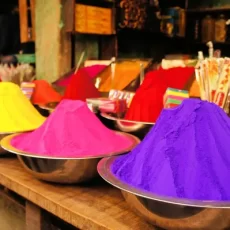Holi commemorates the end of winter and the commencement of spring. In many parts of the country, the festival symbolises the burning of human desires that can inhibit one’s growth. Krishna is a very important figure during the Holi celebrations and it is Krishna who says the following works to Arjuna, on the battlefield of Kurukshetra (a place near Delhi) in Mahabharata:
Dhyayato vishayaan pumsah, vangas teshupa jaayate
Sangaat sanjaayate kaamah, kaamat krodhobhi jaayate
Krodhad bhavati sammohah, sammohat smriti vibramaha
Smriti bhramsaad buddhi nasho, buddhi maashaat pranasyati
While engaging with sensual and material objects, humans become attached to them. Such an attachment develops lust and generates anger when the attachment is not fulfilled. This anger leads to delusion which further leads to mental bewilderment. When the mind finds itself bewildered all the logic and clarity is lost. And with the logic, rationale and clarity getting eroded slowly, a human being progresses slowly towards decay.
Holi is an occassion to detach oneself from such objects and thus, to prevent one’s evitable downfall. It is an occassion to rise towards one’s spiritual growth and fulfillment.
The festival of colours also celebrates the conquest of lust by Shiva and thus, he is known as Kameshwara. The story is as follows.
Shiva was engaged in a deep trance in his Tapas (penance). Kaama was known as the son of Krishna and Rukmini. His wife was Rati.
Lord Indira, the king of the Devas, wanted a commander to lead their forces in their war against the demon Tarakasura. Taraka was the son of Vajranga and Varangi. He gained the trust of Lord Bhrahmadeva by a severe penance on the Pariyatra mountain. When Brahma appeared before him, he asked as a boon (vara) that he should not be killed by anyone other than a seven day old child. Brahma granted him the same.
Manipulating this boon, Taraka began to oppress the Devas, who in their helplessness approached Brahma for his help to destroy Taraka. Brahma told the devas that only a child of Shiva could destroy Taraka.
For this they sought the help of Kaama or Maara or Manmatha, the god of love in Hindu mythology to Shiva to bring him out of his meditation and generate an issue with Parvati. This alone could destroy Tarakasura. Kaama agreed to undertake this mission.
Kaama shot his arrows at Shiva but he was not disturbed from his trance. Kaama then shot a powerful arrow in a final effort to wake Shiva up. At this, Shiva was offended and opened only his fiery third eye and Kaama was burnt and turned to ashes instantly. Subsequently, at the request of Rati and the devas, Shiva restored Kaama from the ashes in the form of Pradyumna. His intimate friend is Vasanta or the Spring.
Shiva and Parvati then created Kaartikeya to destroy Tarakasura. Later, Kartikeya was born and slew the demon Taraka on the seventh day of his birth.
The story goes on to show how Shiva did not give in to Kaama’s charm and also ended up defeating Tarakasura.

